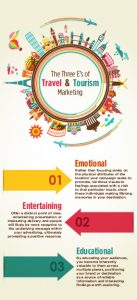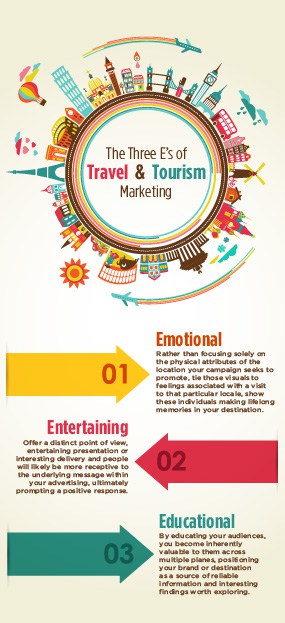
Using Emotional, Entertaining and Educational Content in Travel and Tourism Marketing
Why do we travel? As members of the human race, we are born with an innate penchant for curiosity—a desire to explore beyond our immediate surroundings. Our migratory patterns may have evolved with time, however the pull of unknown, foreign lands and exotic cultures still has a firm hold on the majority of mankind. Whether it is adventure, relaxation or glamour that we crave, our predisposition for travel remains a highly emotional, often spiritual experience, capable of promoting personal growth and development while rewarding us with lasting and meaningful memories.
However satisfying a travel experience might be, it is still largely thought of as a luxury expense – one that can be put off in the wake of necessities. Further, with economic downturn and prevailing increases in cost of living, many households have been forced to cut down their travel plans by either shortening their overnight stays or decreasing their number of planned trips. As if those deterrents weren’t a large enough obstacle for travel, most Americans only have two or three weeks of vacation time, and that’s if they take it all. According to CNN, only 57 percent of Americans use up all of their vacation days per year.
For travel and tourism marketers, this shortage in vacation opportunities means steeper competition when it comes to capturing the attention of potential visitors. Consumers are bombarded with destination marketing on a daily basis, bombarded across all mediums with promises of white sands, bright lights or sunny days, constantly pushing them to BOOK NOW. In the madness of a highly saturated market, many advertisers are left wondering, “How can I break through the clutter?”
Understanding the Mindset of the Modern Traveler
To understand how to effectively tap into the travel and tourism market, you must first understand your audience. We are naturally inquisitive and are exceptional at finding patterns, logic and meaning. We determine an object or service’s worth by tying benefits and rewards with emotional attributes, thereby giving it value and a meaningful purpose. Marketers have been leveraging this inclination to create meaning for decades, drawing a path to a deeper connection by infusing messaging with personal pulls. A diamond becomes a symbol of everlasting love. A smartphone goes from a piece of technology to a source of entertainment for little ones, and a break for mom. An online course gives you the tools and knowledge to unlock your true potential. By attaching emotion to material belongings, a true sense of purpose is created for the object. Travel and tourism marketing is no different.
By taking into account the psychological motivators behind behavior and emotional reactions related to travel and tourism, marketers are able to present their destinations as the more attractive choice to consumers. The use of emotive content connects at the primal levels of our brain in the limbic system, which controls how we feel. It generally overrules the logical neocortex section of the brain. By connecting at this primal level, we create more thought provoking and engaging content.
What Happens when You Fail to Connect?
Without an emotional response prompting us to associate a feeling or meaning to an item or service, the experience falls flat. As per the IPA dataBANK, campaigns with purely emotional content performed about twice as well (31 percent versus 16 percent) as those with only rational content. This emotional content solicits brand advocacy by creating a relationship between the destination and visitors that delves past the surface and connects with audiences on a level that is able to create stronger emotional ties. Without an emotional hook, a beach is just sand and water, not an opportunity to experience the ultimate relaxation of a sun-drenched escape, and a destination is likely to lose the potential to be magical.
Rethink Your Approach: The Most Powerful Strategies in Destination Marketing
As advertisers, we must constantly seek to improve our craft, making our output more influential by infusing it with skillfully refined strategies and actionable content. When it comes to travel and tourism, leveraging a destination’s most unique qualities and engaging opportunities makes it differ and stand out from even comparatively similar areas. While there is no step-by-step guide to a successful, emotionally engaging travel and tourism campaign, there are a few powerful strategies you can begin to incorporate into your messaging to better captivate potential visitors.
- Create emotional, entertaining and educational content.
As mentioned earlier, what makes an object or service valuable depends on its audience’s perceptions of its worth. Creating content that appeals to visitors on an emotional, entertaining or educational level can generate engagement that transcends a destination marketing campaign and becomes a fully engrained, visceral experience that demands action.Make Them Feel SomethingWhile theme parks and coastlines are visually appealing, imagery alone can quickly become ineffective when it comes to destination marketing. Rather than focusing solely on the physical attributes of the location your campaign seeks to promote, tie those visuals to the feelings associated with a visit to that particular locale, show these individuals making lifelong memories in your destination. The stomach-turning, incomparable thrill of a rollercoaster’s dip, the instant relief from the heat upon running into cool, crashing waves, the heart fluttering elation of a romantic getaway for two—show your visitors how they could feel and create meaning and purpose for a visit.Being Charismatic Never Hurts
No one likes a hard sell. Focusing too much of your marketing energy on shoving meaningless content in front of your potential visitors will not deliver the results you are looking for and will ultimately cause your message to become invisible through oversaturation. By instead offering a distinct point of view, entertaining presentation or interesting delivery, people will likely be more receptive to the underlying message within your advertising, ultimately prompting a positive response.
Teach Them Something They Didn’t Already Know
By educating your audiences, you become inherently valuable to them across multiple planes. Perhaps your destination boasts the highest number of “haunted” inns in the state. Maybe your small town comes alive for an independent film festival each autumn. Imparting knowledge on your potential or even repeat visitors on subjects that might appeal to them while laying off invasive “BOOK NOW” content positions your destination as a source of reliable information and interesting findings worth exploring.
- Know the stages of consumer travel.
With a greater understanding of the psychology behind travel, tourism, and leisure, marketing professionals are better able to craft effective campaigns. Do the research. Learn the tactics. Approach the creation of content from an educated perspective and focus on delivering your key messages at times when your intended audiences will be most receptive to them. Throughout our experience working with destinations and crafting multi-dimensional travel and tourism campaigns, we’ve identified the following stages of consumer planning and how to best reach audiences during those times. - Integrate marketing across all media.
An integrated marketing campaign allows us to keep conversations going and drive audience engagement across today’s most influential channels. Bringing your messaging to channels your audience might already be frequenting creates more opportunities for conversion and, by allowing visitors to share their experiences and personal content, can strengthen brand advocacy and loyalty. - Use proper metrics to maximize content performance.
As best practices for travel and tourism marketing change, so, too, do the most appropriate metrics for analyzing performance. When making the choice to run a fully integrated, multi-faceted destination marketing campaign, it is vital to employ specific metrics for each different medium, as failure to do so can result in inaccurate reporting.
Hard Work Pays Off
By leveraging emotional connections and engaging content in advertising campaigns, travel and tourism marketers can generate deeper, positive interactions with audiences, higher recall and create longer lasting, more robust campaign. This is achieved through emotional marketing’s ability to dramatically affect the way people respond to messaging and impact positive involvement with the actual campaigns. Optimistic emotions can also be transferred to the brand, or in this case destination, enhancing perceptions and forging a deeper connection with the campaign.
Ultimately, the goal of any destination marketing campaign is to boost bookings and visitations, as well as deliver a measurable return on investment. A campaign that successfully taps into the visitor’s emotional bank and deposits a memorable connection can, and will, achieve just that. An example of such a campaign can be found in our own recent work for the Jamaica Grande Resort. Asking the resort’s Facebook following to share the romantic and cherished details of their engagement story, the “Ring in the New Year Contest” grew engagement with the brand and created loyalty amongst their audiences.
When it comes to travel and tourism marketing, as with most aspects of the advertising realm, today’s strategies have the potential to be yesterday’s news by tomorrow. While we are part of a constantly evolving, highly unpredictable industry, some things do have enough traction to be considered “tried and true.” Marketing with an emotional appeal and forging connections with visitors can effectively transform your destination’s marketing efforts and ignite the spark potential visitors need to click that elusive BOOK NOW button.
